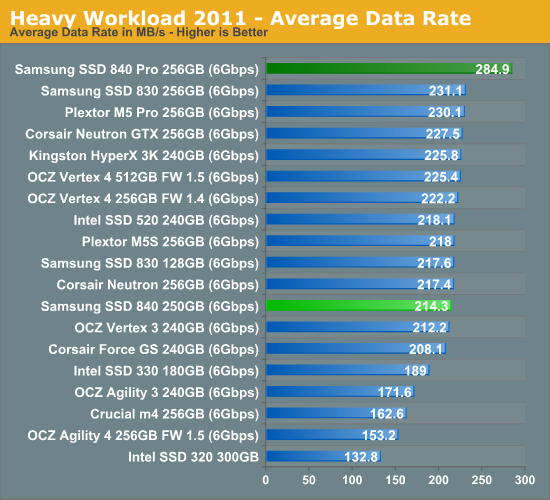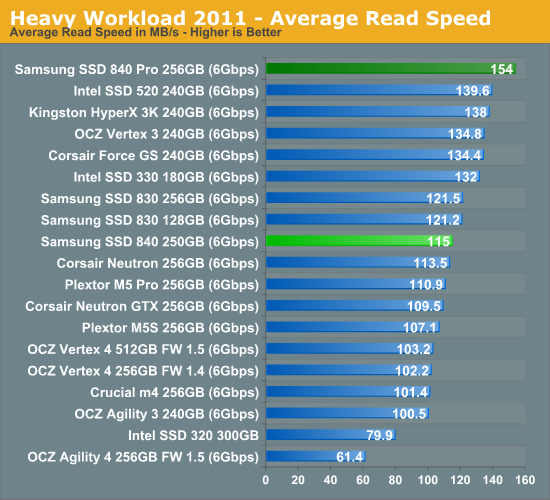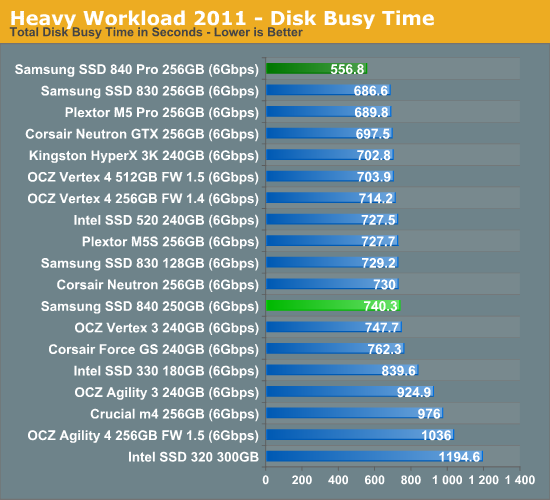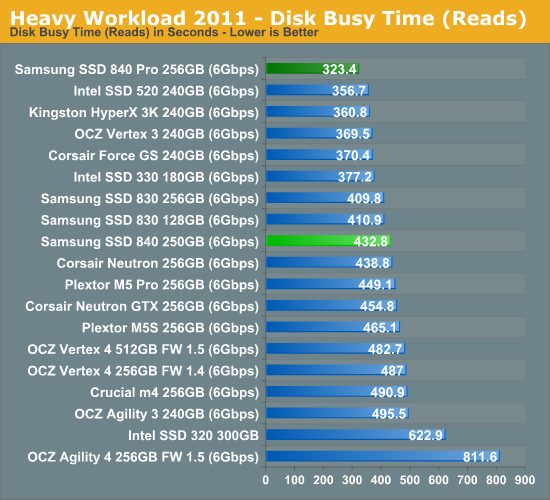Samsung SSD 840 (250GB) Review
by Kristian Vättö on October 8, 2012 12:14 PM EST- Posted in
- Storage
- SSDs
- Samsung
- TLC
- Samsung SSD 840
AnandTech Storage Bench 2011
Last year we introduced our AnandTech Storage Bench, a suite of benchmarks that took traces of real OS/application usage and played them back in a repeatable manner. Anand assembled the traces out of frustration with the majority of what we have today in terms of SSD benchmarks.
Although the AnandTech Storage Bench tests did a good job of characterizing SSD performance, they weren't stressful enough. All of the tests performed less than 10GB of reads/writes and typically involved only 4GB of writes specifically. That's not even enough exceed the spare area on most SSDs. Most canned SSD benchmarks don't even come close to writing a single gigabyte of data, but that doesn't mean that simply writing 4GB is acceptable.
Originally we kept the benchmarks short enough that they wouldn't be a burden to run (~30 minutes) but long enough that they were representative of what a power user might do with their system. Later, however, we created what we refer to as the Mother of All SSD Benchmarks (MOASB). Rather than only writing 4GB of data to the drive, this benchmark writes 106.32GB. This represents the load you'd put on a drive after nearly two weeks of constant usage. And it takes a long time to run.
1) The MOASB, officially called AnandTech Storage Bench 2011—Heavy Workload, mainly focuses on the times when your I/O activity is the highest. There is a lot of downloading and application installing that happens during the course of this test. Our thinking was that it's during application installs, file copies, downloading, and multitasking with all of this that you can really notice performance differences between drives.
2) We tried to cover as many bases as possible with the software incorporated into this test. There's a lot of photo editing in Photoshop, HTML editing in Dreamweaver, web browsing, game playing/level loading (Starcraft II and WoW are both a part of the test), as well as general use stuff (application installing, virus scanning). We included a large amount of email downloading, document creation, and editing as well. To top it all off we even use Visual Studio 2008 to build Chromium during the test.
The test has 2,168,893 read operations and 1,783,447 write operations. The IO breakdown is as follows:
| AnandTech Storage Bench 2011—Heavy Workload IO Breakdown | ||||
| IO Size | % of Total | |||
| 4KB | 28% | |||
| 16KB | 10% | |||
| 32KB | 10% | |||
| 64KB | 4% | |||
Only 42% of all operations are sequential; the rest ranges from pseudo to fully random (with most falling in the pseudo-random category). Average queue depth is 4.625 IOs, with 59% of operations taking place in an IO queue of 1.
Many of you have asked for a better way to really characterize performance. Simply looking at IOPS doesn't really say much. As a result we're going to be presenting Storage Bench 2011 data in a slightly different way. We'll have performance represented as Average MB/s, with higher numbers being better. At the same time we'll be reporting how long the SSD was busy while running this test. These disk busy graphs will show you exactly how much time was shaved off by using a faster drive vs. a slower one during the course of this test. Finally, we will also break out performance into reads, writes, and combined. The reason we do this is to help balance out the fact that this test is unusually write intensive, which can often hide the benefits of a drive with good read performance.
There's also a new light workload for 2011. This is a far more reasonable, typical every day use case benchmark. It has lots of web browsing, photo editing (but with a greater focus on photo consumption), video playback, as well as some application installs and gaming. This test isn't nearly as write intensive as the MOASB but it's still multiple times more write intensive than what we were running last year.
We don't believe that these two benchmarks alone are enough to characterize the performance of a drive, but hopefully along with the rest of our tests they will help provide a better idea. The testbed for Storage Bench 2011 has changed as well. We're now using a Sandy Bridge platform with full 6Gbps support for these tests.
AnandTech Storage Bench 2011—Heavy Workload
We'll start out by looking at average data rate throughout our new heavy workload test:

The 840 is quite average in our Heavy suite and performs similarly to most SandForce drives. The 840 Pro is a lot faster under heavy workloads, so it should be obvious by now why Samsung is offering two SSDs instead of one like they used to.


The next three charts just represent the same data, but in a different manner. Instead of looking at average data rate, we're looking at how long the disk was busy for during this entire test. Note that disk busy time excludes any and all idles, this is just how long the SSD was busy doing something:













86 Comments
View All Comments
iwod - Tuesday, October 9, 2012 - link
I would be buying an Intel instead if it cost $109.99. While Sammy is possibly the closest to intel in terms of reliability. I wouldn't want a TLC SSD for the same price. And the difference would be marginal anyway. I could feel the difference between a decent 3Gbps SSD and 6Gbps SSD, i am not sure if there is anything to feel for two decent 6Gbps SSD.Now if the retail price is really in the range of $70 - 80 that would be a huge difference. Because you are essentially choosing the second best reliable SSD for decent performance and cheapest price.
Death666Angel - Tuesday, October 9, 2012 - link
The Samsung 830 is the 7th cheapest SSD (based on €/GB) I can find on my go-to price comparison website. 3 of the six before it are much slower Kingston/OCZ drives and the other 3 have SF controllers. Considering the kind of inconsistent performance that delivers and the track record, I would go with the Samsung all the time.Now, the 840 just launched and the pricing here is 25% above the 830. But it isn't even available for shipping anywhere. So I don't think that your comparison based on the Vertex4 ship has been shipping for months has any relevance. Also, aren't the Vertex4 numbers with their turbo-mode enabled which stops working after filling the drive to 50%? The Vertex4 256GB model costs 175€, the Samsung 830 256GB model costs 148€. Do you really think the 840 will be more expensive than the 830 in a couple of months? And even so, do you think the Vertex4 if that much better for consumers than the 830? I just don't see it.
Blazorthon - Monday, October 29, 2012 - link
Actually, the slowing down after 50% and such for Vertex 4 was fixed in firmware 1.5. The current numbers don't rely on Turbo, they're all the time.Also, to all of you, Vertex 4, unlike its predecessors, uses a Marvell-designed controller. Anyone who's used a Crucial or Plextor SSD probably knows that Marvell based SSDs are about as reliability as you can get, up there with Samsung and Intel. Vertex 4 is OCZ's most reliable SSD to date by huge margins, especially with current firmware where it rivals even Samsung and the others in reliability unlike the original firmware (which was specifically stated to be in beta, so anyone who bought Vertex 4 around launch time without doing their research and finding that out probably isn't someone who should be allowed to buy their own SSDs without expert help).
Also, IDK about UK prices, but in the USA, the Vertex 4, Samsung 830, Samsung 840, and occasionally also the Crucial M4 and Plextor M5S are all at about the same price points for 64GB, 128GB, and 256GB capacities right now. As someone who has experience with Vertex 4, I'd definitely recommend it over Samsung 830 and Samsung 840 so long as it's not more expensive.
Assimilator87 - Monday, October 8, 2012 - link
How come the OCZ 4 series just suddenly disappear when the review gets to the power consumption tests?JarredWalton - Monday, October 8, 2012 - link
Because Kristian imported the results from SSD Bench for the "1.4 Firmware" for the OCZ drives, and when those were retested Anand didn't add in power use figures. I've added them to the graphs using the original power figures at release. Thanks for the heads up!Coup27 - Monday, October 8, 2012 - link
Excellent article Kristian, enjoyed it.Some constructive criticism, although I appreciate that English is not your native language. Sentences aren't that clear when you use a double negative, such as "I wouldn't find it unlikely...". It would be much clearer if you had wrote "It would be likely..."
Kristian Vättö - Monday, October 8, 2012 - link
Point taken, thanks for the feedback :-)Some things sound logical in my ears but they may not make much sense for a native speaker. I guess this is partially because in English exams and stuff, using more difficult sentence structures (like double negative) will yield higher scores, even though they are not commonly used by natives. Will try to pay more attention to this in the future.
Sufo - Tuesday, October 9, 2012 - link
I don't know if I agree with this. While double negatives are certainly inappropriate in some situations, the example you give is nit picking. Add to that, there is a subtle (albeit not technical) difference between "I wouldn't find it unlikely" and "I would find it likely". I accept that had Kristian made a legitimate grammatical error, then correcting it (while a little pedantic) may have been justified, but simply editing for style seems unnecessary.I guess my point is Kristian was not objectively wrong, or even unclear (although admittedly, complexity for complexity's sake benefits no one) and so he shouldn't pay too much heed to comments like this simply because OP is an English speaking native and he is not. I am, however, confident that he's more than capable of coming to his own conclusions on the matter :P
smartthanyou - Monday, October 8, 2012 - link
I am probably in the minority on this, but as a matter of policy, I don't think you should call anything a review without pricing and a approximate release date.Particularly the price. If I don't see a price, I don't bother to read the article.
sean.crees - Monday, October 8, 2012 - link
Price is on the 5th page labeled "The Samsung SSD 840" about half way down.Although i noticed the price for the 840 250GB is the same as the 840 Pro's 256GB? Is this a typo? Why would anyone buy the non pro with 6 less GB and slower speeds for the same price?